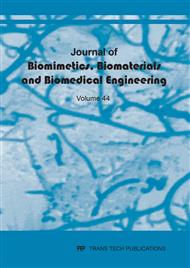[1]
P. Zahedi, I. Rezaeian, S.O. Ranaei‐Siadat, S.H. Jafari, P. Supaphol, A review on wound dressings with an emphasis on electrospun nanofibrous polymeric bandages, Polymers for Advanced Technologies. 21 (2010) 77-95.
DOI: 10.1002/pat.1625
Google Scholar
[2]
Z. Moore, G. Butcher, L. Corbett, W. McGuinness, R. Snyder, K. Van Acker, Managing wounds as a team–exploring the concept of a team approach to wound care, J Wound Care. 23 (2014) 1-38.
DOI: 10.12968/jowc.2014.23.sup5b.s1
Google Scholar
[3]
S. Çalamak, C. Erdoğdu, M. Özalp, K. Ulubayram, Silk fibroin based antibacterial bionanotextiles as wound dressing materials, Materials Science and Engineering: C. 43 (2014) 11-20.
DOI: 10.1016/j.msec.2014.07.001
Google Scholar
[4]
M. Uzun, S. Anand, T. Shah, In vitro characterisation and evaluation of different types of wound dressing materials, Journal of Biomedical Engineering and Technology. 1 (2013) 1-7.
Google Scholar
[5]
D.N. Rockwood, R.C. Preda, T. Yücel, X. Wang, M.L. Lovett, D.L. Kaplan, Materials fabrication from Bombyx mori silk fibroin, Nature protocols. 6 (2011) 1612.
DOI: 10.1038/nprot.2011.379
Google Scholar
[6]
V. Kearns, A. MacIntosh, A. Crawford, P. Hatton, Silk-based biomaterials for tissue engineering, Topics in tissue engineering. 4 (2008) 1-19.
Google Scholar
[7]
A. Panico, F. Paladini, M. Pollini, Development of regenerative and flexible fibroin‐based wound dressings, Journal of Biomedical Materials Research Part B: Applied Biomaterials. (2018).
DOI: 10.1002/jbm.b.34090
Google Scholar
[8]
R.L. Moy, A. Lee, A. Zalka, Commonly used suture materials in skin surgery, Am Fam Physician. 44 (1991) 2123-2128.
Google Scholar
[9]
L. Pari, D. Tewas, J. Eckel, Role of curcumin in health and disease, Archives of physiology and biochemistry. 114 (2008) 127-149.
DOI: 10.1080/13813450802033958
Google Scholar
[10]
V.C. Nguyen, V.B. Nguyen, M.-F. Hsieh, Curcumin-loaded chitosan/gelatin composite sponge for wound healing application, International Journal of Polymer Science. 2013 (2013).
DOI: 10.1155/2013/106570
Google Scholar
[11]
R. Wilken, M.S. Veena, M.B. Wang, E.S. Srivatsan, Curcumin: A review of anti-cancer properties and therapeutic activity in head and neck squamous cell carcinoma, Molecular cancer. 10 (2011) 12.
DOI: 10.1186/1476-4598-10-12
Google Scholar
[12]
Y. Lian, J.-C. Zhan, K.-H. Zhang, X.-M. Mo, Fabrication and characterization of curcumin-loaded silk fibroin/P (LLA-CL) nanofibrous scaffold, Frontiers of Materials Science. 8 (2014) 354-362.
DOI: 10.1007/s11706-014-0270-8
Google Scholar
[13]
X. Li, J. Qin, J. Ma, Silk fibroin/poly (vinyl alcohol) blend scaffolds for controlled delivery of curcumin, Regenerative biomaterials. 2 (2015) 97-105.
DOI: 10.1093/rb/rbv008
Google Scholar
[14]
X. Zhang, Z. Chen, H. Bao, J. Liang, S. Xu, G. Cheng, Y. Zhu, Fabrication and Characterization of Silk Fibroin/Curcumin Sustained-Release Film, Materials. 12 (2019) 3340.
DOI: 10.3390/ma12203340
Google Scholar
[15]
K. Chellamani, R. Vignesh Balaji, D. Veerasubramanian, Quality evaluation methods for textile substrates based wound dressings, IJETAE. 4 (2014) 811-17.
Google Scholar
[16]
B. EN, 13726-1: 2002, Test methods for primary wound dressing, Aspects of Absorbency, BSI, ISBN 0 580 39510 3, British Standard Institute. (2002).
Google Scholar
[17]
D. Parsons, P.G. Bowler, V. Myles, S. Jones, Silver antimicrobial dressings in wound management: a comparison of antibacterial, physical, and chemical characteristics, Wounds-a compendium of clinical research and practice. 17 (2005) 222-232.
Google Scholar
[18]
M. Mondal, The silk proteins, sericin and fibroin in silkworm, Bombyx mori Linn.,-a review, Caspian Journal of Environmental Sciences. 5 (2007) 63-76.
Google Scholar
[19]
M. Sah K. Pramanik, Regenerated silk fibroin from B. mori silkcocoon for tissue engineering applications, International journal of environmental science and development. 1 (2010) 404.
DOI: 10.7763/ijesd.2010.v1.78
Google Scholar
[20]
E.S. Gil, B. Panilaitis, E. Bellas, D.L. Kaplan, Functionalized silk biomaterials for wound healing, Advanced healthcare materials. 2 (2013) 206-217.
DOI: 10.1002/adhm.201200192
Google Scholar
[21]
W. Tiyaboonchai, P. Chomchalao, S. Pongcharoen, M. Sutheerawattananonda, P. Sobhon, Preparation and characterization of blended Bombyx mori silk fibroin scaffolds, Fibers and Polymers. 12 (2011) 324.
DOI: 10.1007/s12221-011-0324-9
Google Scholar
[22]
N. Kasoju U. Bora, Fabrication and characterization of curcumin‐releasing silk fibroin scaffold, Journal of Biomedical Materials Research Part B: Applied Biomaterials. 100 (2012) 1854-1866.
DOI: 10.1002/jbm.b.32753
Google Scholar
[23]
C.-W. Lou, C.-W. Lin, Y.-S. Chen, C.-H. Yao, Z.-S. Lin, C.-Y. Chao, J.-H. Lin, Properties evaluation of tencel/cotton nonwoven fabric coated with chitosan for wound dressing, Textile research journal. 78 (2008) 248-253.
DOI: 10.1177/0040517507089747
Google Scholar
[24]
J. Dale, Wound dressings, Professional nurse (London, England). 12 (1997) S12-4.
Google Scholar


